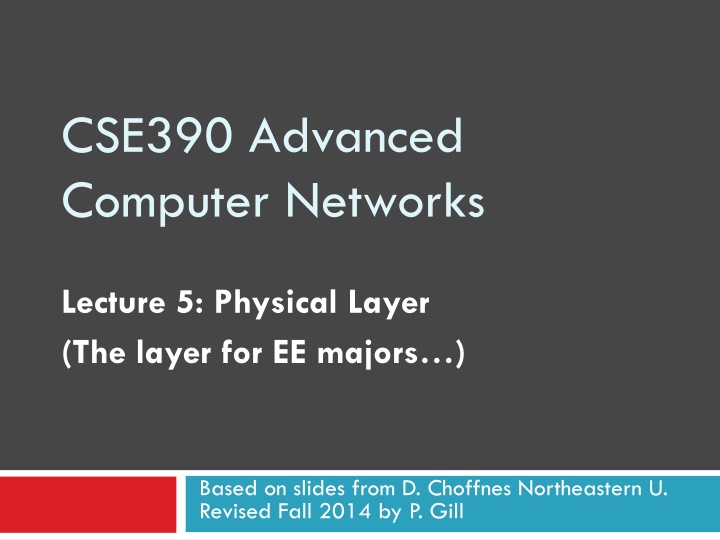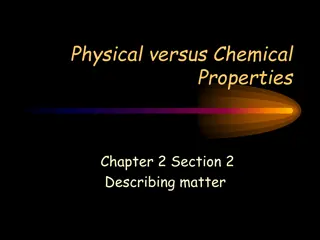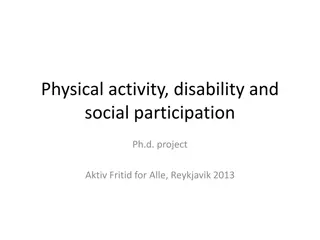
Advanced Computer Networks: Physical Layer Function and Challenges
Explore the intricacies of the physical layer in advanced computer networks, covering the transmission of bits across a physical medium, challenges in representing bits in analog, and solutions like Non-Return to Zero (NRZ) and Non-Return to Zero Inverted (NRZI) encoding schemes. Dive deep into concepts like desynchronization, clock recovery, and Ethernet encoding strategies for optimal data transfer rates.
Download Presentation

Please find below an Image/Link to download the presentation.
The content on the website is provided AS IS for your information and personal use only. It may not be sold, licensed, or shared on other websites without obtaining consent from the author. If you encounter any issues during the download, it is possible that the publisher has removed the file from their server.
You are allowed to download the files provided on this website for personal or commercial use, subject to the condition that they are used lawfully. All files are the property of their respective owners.
The content on the website is provided AS IS for your information and personal use only. It may not be sold, licensed, or shared on other websites without obtaining consent from the author.
E N D
Presentation Transcript
CSE390 Advanced Computer Networks Lecture 5: Physical Layer (The layer for EE majors ) Based on slides from D. Choffnes Northeastern U. Revised Fall 2014 by P. Gill
Physical Layer 2 Function: Get bits across a physical medium Application Presentation Session Transport Network Data Link Physical Key challenge: How to represent bits in analog Ideally, want high-bit rate But, must avoid desynchronization
Key challenge 3 Digital computers 0s and 1s Analog world Amplitudes and frequencies
Assumptions 4 We have two discrete signals, high and low, to encode 1 and 0 Transmission is synchronous, i.e. there is a clock that controls signal sampling Sample Time Amplitude and duration of signal must be significant
Non-Return to Zero (NRZ) 5 1 high signal, 0 low signal 0 0 1 0 1 0 1 1 0 0 NRZ Clock Problem: long strings of 0 or 1 cause desynchronization How to distinguish lots of 0s from no signal? How to recover the clock during lots of 1s?
Desynchronization 6 Problem: how to recover the clock during sequences of 0 s or 1 s? 0 1 1 1 1 1 1 1 1 0 NRZ 1 1 1 1 1 0 1 1 0 Receiver misses a 1 due to skew Transitions signify clock ticks
Non-Return to Zero Inverted (NRZI) 7 1 make transition, 0 remain the same 0 0 1 0 1 0 1 1 0 0 NRZI Clock Solves the problem for sequences of 1s, but not 0s
4-bit/5-bit (100 Mbps Ethernet) 8 Observation: NRZI works as long as no sequences of 0 8-bit / 10-bit used in Gigabit Ethernet Idea: encode all 4-bit sequences as 5-bit sequences with no more than one leading 0 and two trailing 0 4-bit 5-bit 4-bit 5-bit 0000 11110 0001 01001 0010 10100 0011 10101 0100 01010 0101 01011 0110 01110 0111 01111 1000 10010 1001 10011 1010 10110 1011 10111 1100 11010 1101 11011 1110 11100 1111 11101 Tradeoff: efficiency drops to 80%
Manchester 9 1 high-to-low, 0 low-to-high 0 0 1 1 0 NRZI Clock Good: Solves clock skew (every bit is a transition) Bad: Halves throughput (two clock cycles per bit)
General comment 10 Physical layer is the lowest, so We tend not to worry about where to place functionality There aren t other layers that could interfere We tend to care about it only when things go wrong http://blog.level3.com/level-3-network/the-10-most-bizarre-and- annoying-causes-of-fiber-cuts/ Physical layer characteristics are still fundamentally important to building reliable Internet systems Insulated media vs wireless Packet vs. circuit switched media






















